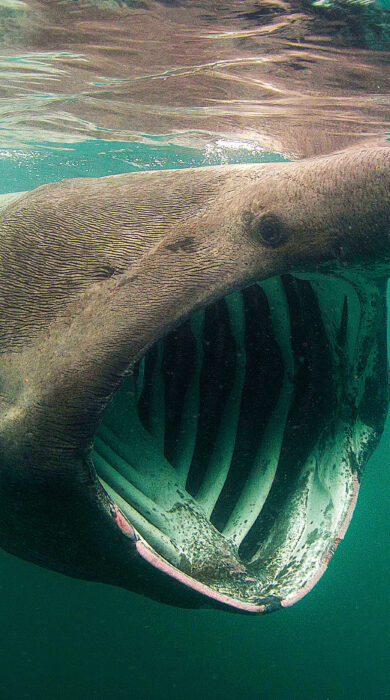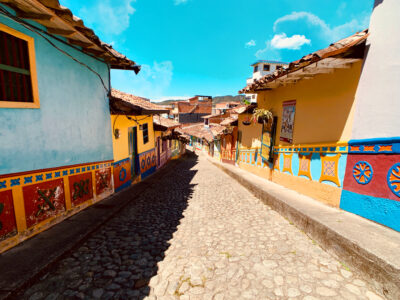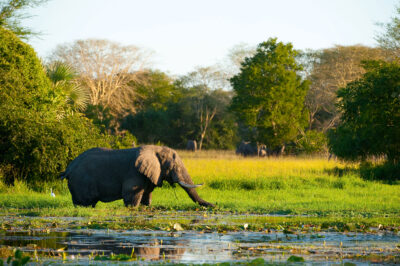
A wildlife guide to Scotland: Basking sharks, orca and seabirds
It’s wild up north! The rugged, empty fringes of Scotland are busier than you’d think, with wildlife scattering its islands, mountains and coast
From orca to crested tits, red deer to razorbills, Scotland has such a rich panoply of wildlife that it would be criminal not to seek it out when exploring the north of Britain. It’s also easier to see than you think. While you can tough it out on the mountains if you wish, watching some of the country’s most charismatic species – puffins, for one – can involve nothing more demanding than idling on the grass in the sunshine.
Scotland isn’t large. The land area is around 80,000 sq km, placing it just above Serbia in size. But, owing to its far-flung island chains, it covers a much vaster expanse, stretching deep into the Atlantic. Hermaness, the northernmost part of Shetland, is closer to the North Pole than, say, Bergen in Norway is, while the archipelago of St Kilda is separated from the Outer Hebrides by some 60km of ocean.
It’s the in-between bits – the cold, nutrient-rich waters – where some of Europe’s greatest wildlife spectacles can be witnessed. Bass Rock in the Firth of Forth, for example, is home to some 75,000 pairs of northern gannets. These glossy-white seabirds have two-metre-wide wingspans and are renowned for plunge-diving at tremendous speeds, hitting the water at 80kph. This breeding colony accounts for around 10% of the species population worldwide.
Orcas patrol the waters off Shetland, Orkney and the mainland, feeding on porpoises and both grey and harbour seals. Equally noteworthy is Gunna Sound, between the Inner Hebridean islands of Coll and Tiree, which is renowned as one of the best places in the world to see basking sharks. These filter-feeding giants can grow to a length of 10m and arrive here in large numbers in the summer.
The Minch, a lonely stretch of water between the Inner and Outer Hebrides, is another area rich in marine wildlife that is worth seeking out. It’s home to more than ten species of cetacean, with minke whales, porpoises and common and bottlenose dolphins all regularly spotted on boat tours.
For more sightings, turn your gaze to the sky. Ospreys have been recolonising Scotland for 70 years, and some 250 pairs migrate here from Africa every year. Both golden and white-tailed eagles are also now widespread across much of the mainland and many of the islands.
Scotland’s common, everyday wildlife is no less appealing. Red deer can be spotted from the southern lowlands to Caithness and Sutherland. Along much of the long coastline, it’s impossible to miss the piping oystercatchers and burbling curlews. Otters, too, are numerous, though spotting them requires plenty of patience and sharp eyes.
Where to see wildlife in Scotland
Shetland

The Shetland archipelago has wildlife to match anywhere in Europe. Must-visit sites include the islands Mousa, where sparrow-sized storm petrels nest in the cracks of a 2,300-year-old broch (drystone tower), and Noss, where its resident gannet colony can be seen plunge-diving en masse. The cliffs at Hermaness are home to delightful colonies of nesting puffins that socialise like village gossips metres from your feet. There, you’ll also find great skuas, or bonxies; these predatory seabirds resemble a cross between a gull and an eagle, and they have a fondness for devouring puffins. Far below, orca pods maraud the surrounding waters like wolf packs, hunting for seals and porpoises.
Best for: Seabirds of all varieties – Arctic terns, fulmars, guillemots, puffins, razorbills and shags – are easy to see during breeding season.
The west coast & Inner Hebrides

Using Oban as a base, take the ferry to Mull, Coll and Tiree or down to Islay, watching from the deck for any sign of a dorsal fin breaking the surface. Day trips to the Corryvreckan whirlpool – between the islands of Jura and Scarba – are also possible from Oban and Easdale. Created by strong tides and unusual underwater topography, the whirlpool attracts gannets and other seabirds, as well as porpoises and dolphins. Mull and Skye are the best places in Scotland to see white-tailed eagles, which were reintroduced here via a programme in the 1970s and ’80s. Watching them snatch mackerel from Mull’s Loch Na Keal is as exhilarating
as any wildlife experience in the world.
Best for: Cetaceans. Minke whales and bottlenose, common and Risso’s dolphins are all commonly sighted off the west coast.
The Cairngorms

Spanning lowland pine forests, freshwater lochs and high mountains, the Cairngorms encompass a rich variety of wildlife. Breeding ospreys and red squirrels are easy to spot in and around Loch Garten in Abernethy Forest, but sightings of capercaillie (pictured above), a turkey-sized bird whose name means ‘woodland horse’, are increasingly rare. Pine martens – a larger relative of the stoat and weasel – are nocturnal, so you’ll need to book a hide with a tour group to see one (see sidebar). Wildcats, however, are very rare; you’ve got a better chance of glimpsing Nessie. Ascending the slopes, you’ll have better luck sighting red deer and ptarmigan, a bird that changes its plumage from mottled brown to all-white in winter.
Best for: Forest birds such as crested tits and crossbills, plus everyone’s favourite – Squirrel Nutkin himself – the native red squirrel.
The Flow Country
The Flow Country of Caithness and Sutherland, high in the north, is a 4,000 sq km landscape of peat bogs and tannin-coloured pools. It is utterly silent except for the calls of greenshanks and skylarks.
Chanonry Point
This spit of land, not far from Inverness, thrusts out into the Moray Firth, from where bottlenose dolphins can be spied feeding on salmon and sea trout on a rising tide.
Outer Hebrides
There are golden eagles all over Scotland, but they can be hard to spot. On the island of Harris, the trail up from Bogha Glas is one of the best locations in all Europe to see these raptors.
Solway Firth
In the south-west, the Solway Firth is a feeding ground for thousands of wildfowl, including some 40,000 barnacle geese.
Beaver sites
There are now beavers living in Scotland, having been reintroduced to Knapdale on the west coast and the Tay Valley in the east. You can also now see them at the RSPB’s Loch Lomond Reserve.
Need to know
When to go
Summer is a great time for spotting breeding seabirds, with May and June offering the best odds of decent weather. Arrive from April onwards for sightings of puffins and terns, while spring is best for spotting ospreys. Birds overwinter on the Solway Firth and islands such as Islay and Tiree between October and March. Golden and white-tailed eagles live in Scotland year round.
Whales and dolphins can be seen all year, but boat trips to view them often run from April to October. Orca – moving between Shetland, Orkney and the northern coast – can be spied from land in any season.
Getting there & around
While Edinburgh and Glasgow are the main flight hubs, you can also fly into Inverness for the Highlands, Kirkwall for Orkney and Sumburgh Head for Shetland. But there are plenty of alternatives to flying. For the west-coast islands, the Caledonian Macbrayne ferry (aka CalMac; calmac.co.uk) is reliable and very cheap. A more elegant route into the Highlands is the Caledonian Sleeper train (sleeper.scot) from London Euston to Fort William, which costs from £140 one-way for a single berth. Lastly, you can, of course, drive – it’s about ten hours from London to Oban.
Activities
Speyside Wildlife is based in the Cairngorms and offers nights in pine marten hides and bespoke days out. Aigas Field Centre runs wildlife tours of the Highlands. On Shetland, Shetland Wildlife can help you to see an orca in the wild. Rewilding and conservation pioneer Alladale Wilderness Reserve has a range of activities for guests and day visitors in its luxurious properties. And for a day like no other, Basking Shark Scotland lets you snorkel with the world’s second-largest fish.


















